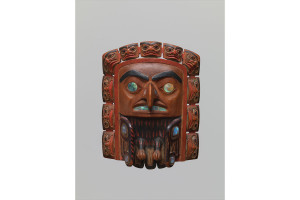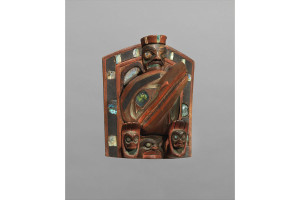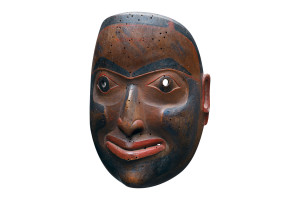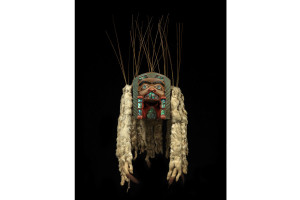
Masks/Frontlets/Clan Helmets
Learn more about Masks, Frontlets and Clan Helmets
The masking traditions of the Northwest Coast First Nations are rich and diverse. They range from complex articulated transformation masks of the Kwakwaka’wakw, which change from one outward appearance to another, to Haida portrait masks carved with a naturalistic quality. The majority were made to be worn on the face, while some figures of particular animals or mythological beings were so large that they were worn on the back. Danced at important social occasions such as the potlatch, masks enacted particular mythological scenes, relayed the oral history of a particular family or clan, or the history of the people it belonged to. Displaying portraits of specific individuals and/or supernatural beings, the performances dramatized communal and familial histories as well as representing historical or mythical events. While most masks were the property of hereditary chiefs and important family members, others belonged to shamans, assisting them in their work by calling upon the spirits of deceased clan or lineage elders and high ranking individuals from other social groups.
Headdresses frontlets and clan helmets were the principal form of ceremonial headgear on the Northwest Coast in the nineteenth century. While frontlets were worn on the forehead, clan helmets were typically hollowed out on the underside to sit directly on top of the head, having evolved from classic war helmets worn by Northern Northwest Coast peoples in the 18th century. Worn on important social occasions by prominent members of a clan or family, both clan hats and frontlets displayed inherited family crests while communicating clan status and associated privileges, rights and obligations. These headdresses were often elaborately embellished with sea lion whiskers, animal fur, and often ermine tails. In addition to rich painting in red, blue and black, many examples were decorated with fragments of abalone shell or mirrors, materials deemed particularly significant by First Nation peoples. The inlay would have reflected firelight and animate the headdress frontlet when worn during notable social occasions.
Status: All
Category: Masks/Frontlets/Clan Helmets
Results: 64












High-resolution images available. Contact Gallery for rights.
